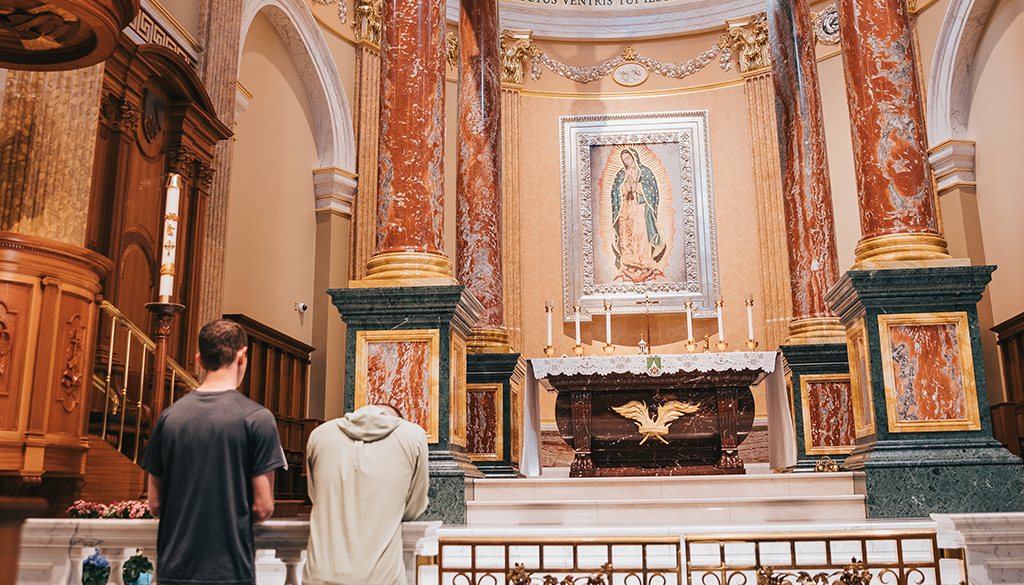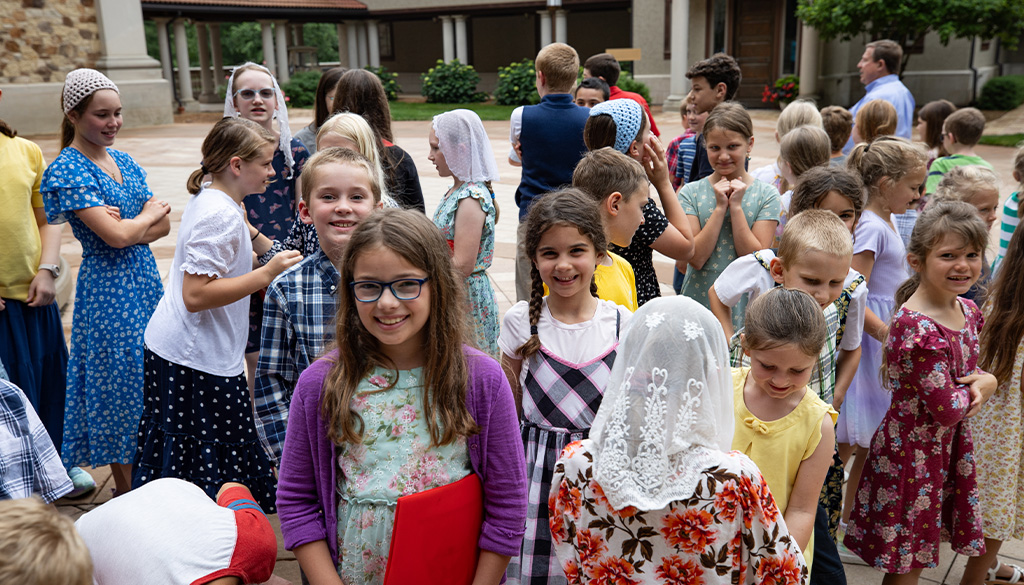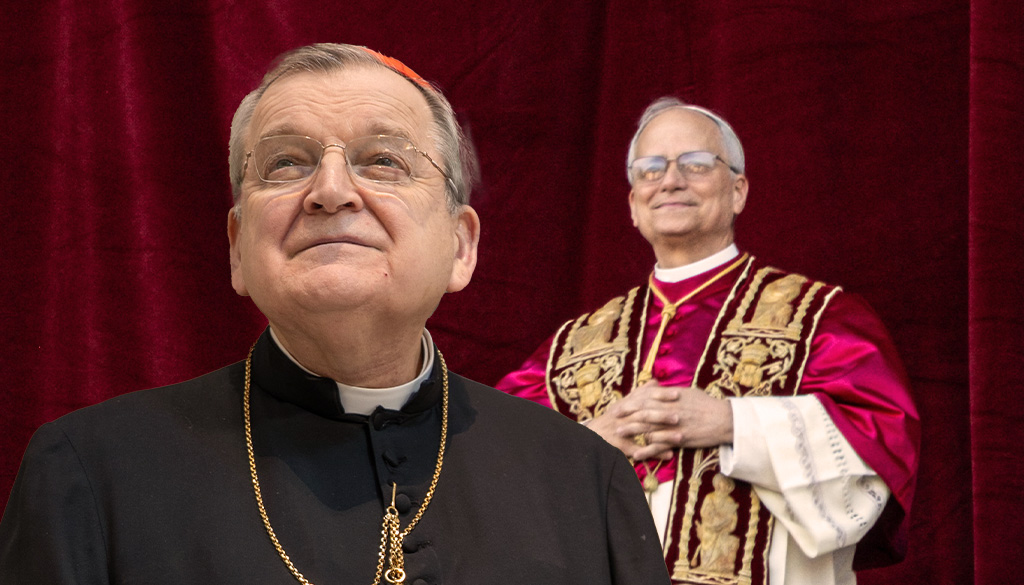Two Days Before the Conclave

On the final day of the “Novendiali”—the nine days of mourning for the passing of Pope Francis in St. Peter’s Basilica at the Vatican—Cardinal Burke passes through crowds of pilgrims and visitors in the Piazza della Città Leonina, just northeast of Vatican City. The long black coat and black fedora does not prevent some in the crowds from noticing the red fringe of his cassock. The faithful gather around him as he nears the entrance to Vatican City and, in various languages, they beseech his blessing. Removing his black fedora from atop his head to give unsparingly his blessing to all who ask, the universal sign of his red zucchetto is suddenly seen by others, who move quickly to receive a blessing in their turn. Cardinal Burke knows that he must be on time for the concluding Mass of the Novendiali, yet he lingers to listen to the testimonies of souls who have been inspired and moved by his ecclesial leadership, his spiritual fatherhood.
Entering Vatican City
Finally, Cardinal Burke is able to cross the Via di Porta Angelica to the Porta Sant’Anna, the most highly trafficked gate of Vatican City, mostly used by prelates and Vatican employees. He enters through a gate on the left side of Via Sant’Anna. Swiss Guards in navy blue uniforms stand at attention and salute him with a casual yet formal greeting, “Buonasera, Eminenza.”
His in-kind response in Italian is joined by a wave and a warm expression. A young Swiss Guard from California gives His Eminence a filial smile, perhaps recalling the fresh memory from the day before when Cardinal Burke had paused to inquire after the young man’s family and his recent travels back to the States. All the Swiss Guards at the Porta Sant’Anna wear navy blue uniforms with berets, unlike the more commonly recognizable uniform of yellow, blue, and red, bearing a distinctly Renaissance appearance with pantaloons and a feathered morion helmet. That is their full dress uniform; the guards at the gate wear the exercise or night uniform, not because of any rank distinction between the guards, but because the dark blue clothing better absorbs dirt from so much traffic passing through the Porta Sant’Anna. It is pragmatic apparel.

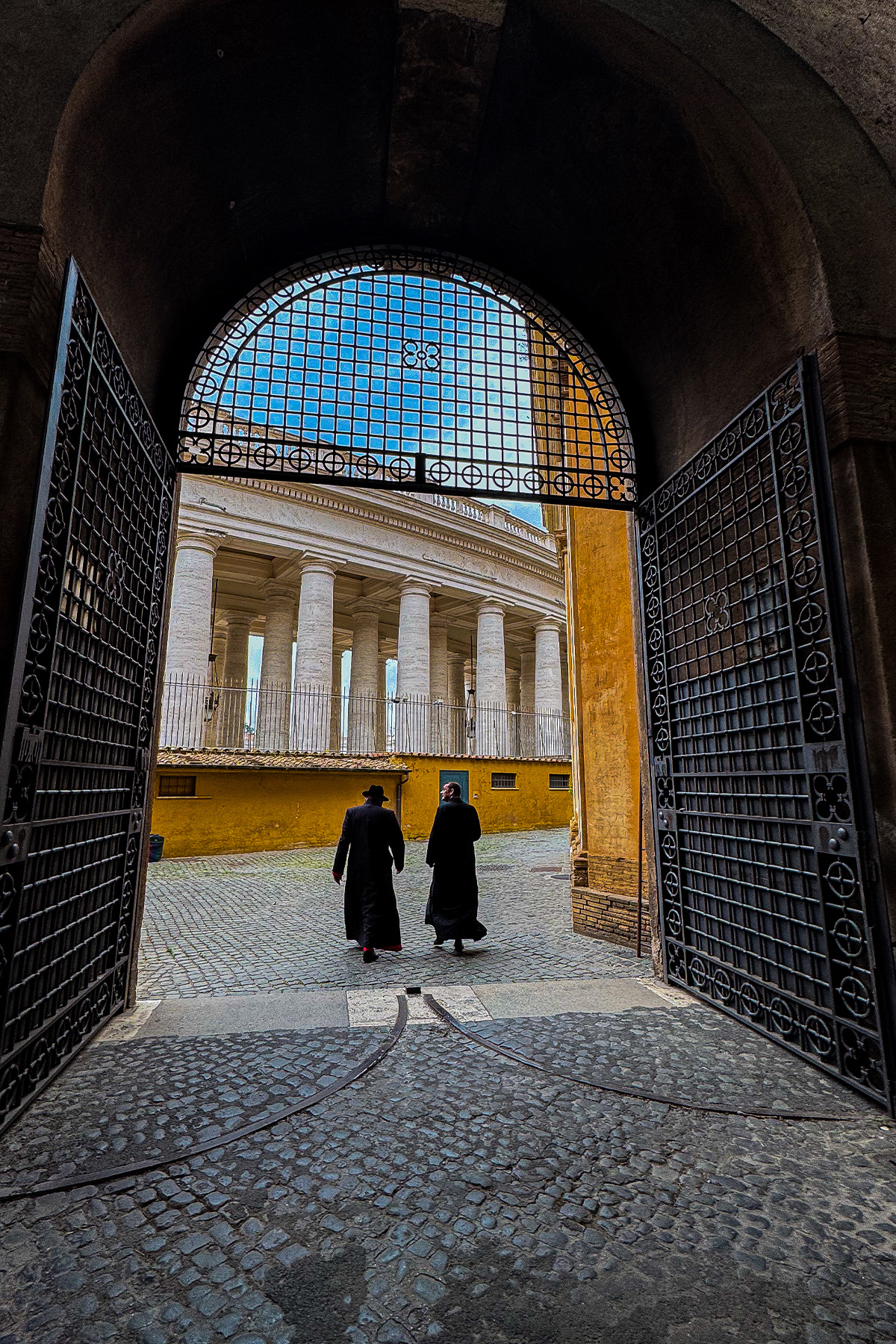
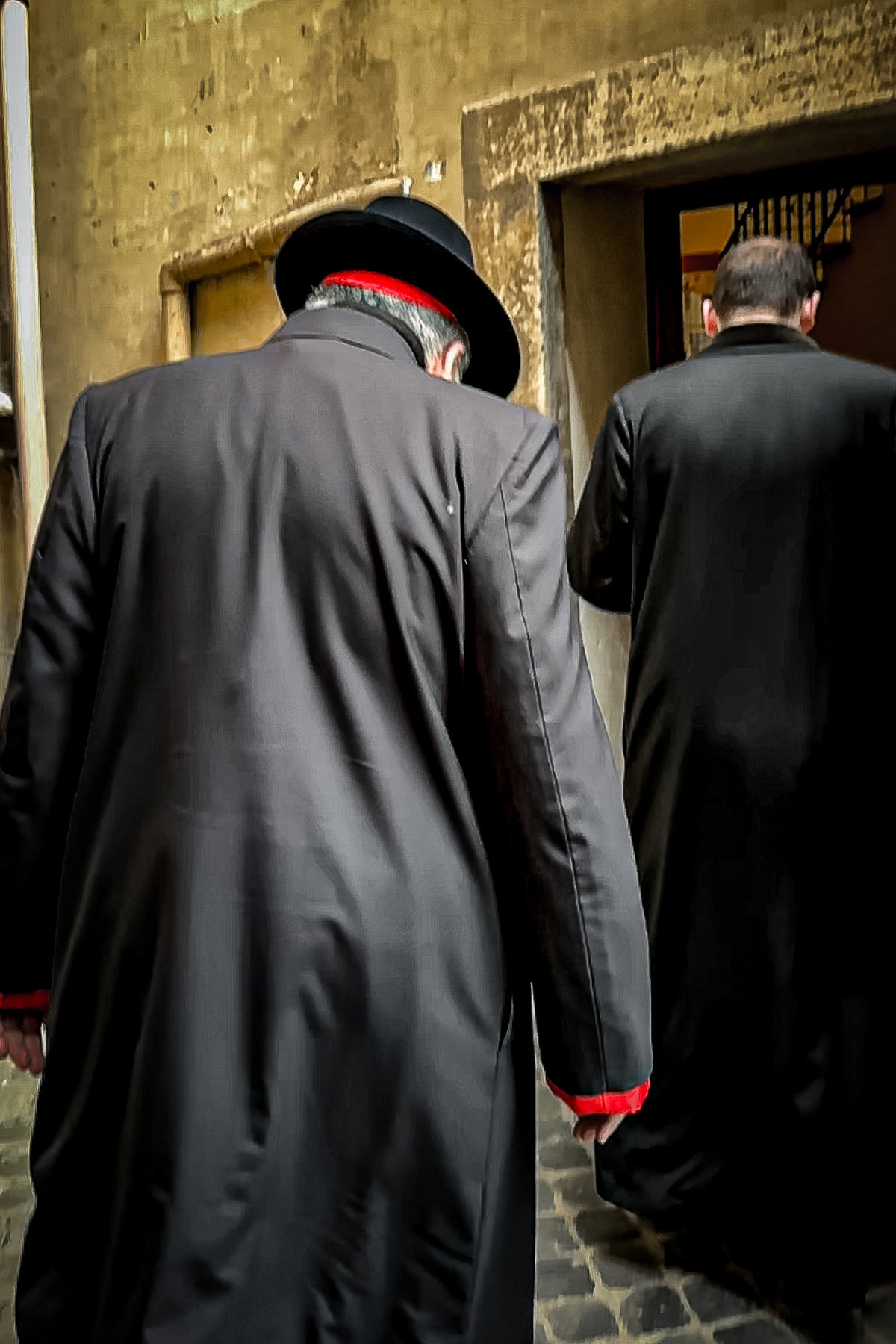
Ways of the Prelates
Beyond the gate, to the right, is the only place in Vatican City where the general public may enter freely for worship and devotion at the Church of Sant’Anna dei Palafrenieri, constructed nearly 500 years ago, one of the first churches in Rome designed in an elliptical style. The general public pass through a gate on the right side of Via Sant’Anna and enter the Church, as Cardinal Burke continues straight ahead toward a destination that some in the crowd crane their necks and strain their eyes to see, a path that Cardinal Burke has trodden countless times before as Seminarian, Priest, Bishop, Archbishop, and now as Cardinal, a path that he knows so well that he barely needs to raise his eyes to see.
Cardinal Burke turns left, down a side street in Vatican City, and walks by the Istituto per le Opere di Religione and the Chiesa dei Santi Martino e Sebastiano degli Svizzeri, on the opposite side of the Apostolic Palace, in a courtyard overshadowed by the canopy of a large sycamore tree. The modern stained glass windows glimpsed through the entryway of the nearby barracks of the Swiss Guards serves as a gentle indication that some changed has happened in this holy place over the last fifty years. Yet much more remains untouched in this metropolis of grace at the core of the Eternal City.
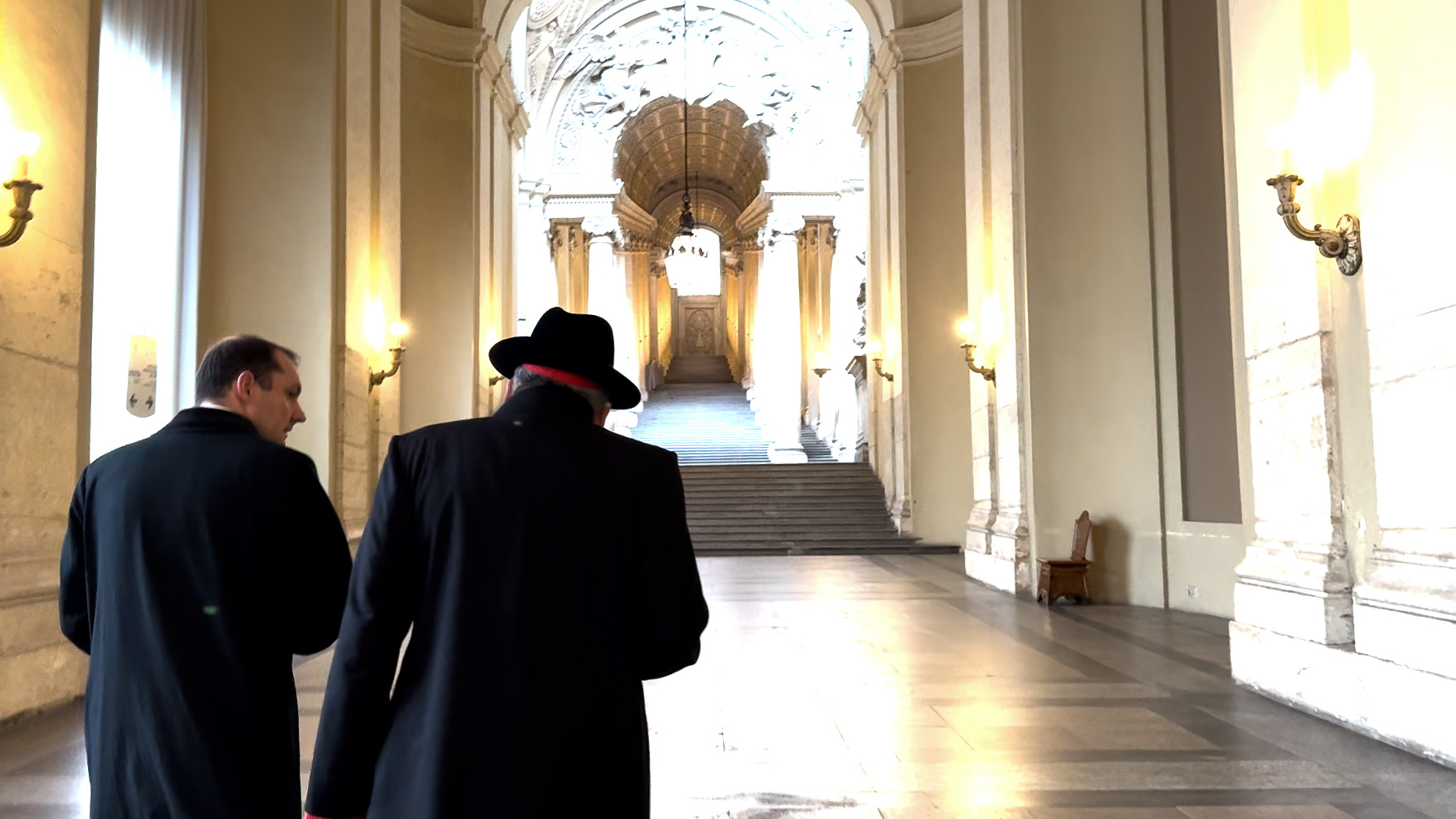
The Scala Regia
Cardinal Burke enters deeper into Vatican City until he comes to an entrance to a flight of steps known as the Scala Regia, part of the formal entrance to the Vatican. Originally built by Antonio da Sangallo the Younger in the 1500’s, the steps were masterfully restored and magnified a century later by the famous sculptor, Bernini. The ornate, barrel-vaulted ceiling is supported by a majestic white colonnade. The air smells of cool stone like the inside of an open, empty tomb at a new Springtide. Along the Scala Regia is a stunning statue of Constantine, his marble expression carved evermore in awe before the words In Hoc Signo Vinces (“In this sign, you will conquer”), meaning the Sign of the Cross, referring to the crucial story of Constantine’s conversion to the Catholic faith, a reminder to all who enter either the Vatican in one direction or St. Peter’s Basilica in the other direction that Christ alone wins every victory.
As Cardinal Burke approaches the Portone di Bronzo at the north side of St. Peter’s Square, he is saluted and greeted by more Swiss Guards, who, no longer near the traffic of the world, wear full dress uniforms, neatly pressed from tunic to pantaloons, with clean bright yellows and dark blues and deep reds. “Buonasera, Eminenza,” they greet him respectfully, yet softly now that they are closer to the Basilica and no longer near the din of the street. He greets them kindly, yet his eyes are fixed on the Church—yes, the Basilica of St. Peter beyond the portal, yet also the Universal Church beyond, the Church on the cusp of a critical transition, a Church dependent on the discussions and decisions of the Sacred College of Cardinals.

Final Day of the Novendiali
Cardinal Burke steps out onto the front porch of St. Peter’s Basilica and shakes hands with other Princes of the Church, who have approached from a different direction. They enter St. Peter’s Basilica together as confreres, leaders, and spiritual fathers. To the right is a long curtain that runs nearly the length of St. Peter’s Basilica and provides a practical yet important divide between the general congregation and the prelates who will be concelebrating the Holy Mass upon the resting place of St. Peter. Behind that curtain, men ordained to the Holy Priesthood pray to God for purification, preparation, and intention before offering Holy Mass, seeking God’s grace to offer worthily the unbloodied sacrifice of the Divine Son and to be worthy of receiving the Body and Blood of Our Lord Jesus Christ.
Cardinal Burke starts to take a step toward an opening in the curtain where other Cardinals are seen going through. But before he takes another step, he looks back, smiles and nods, and offers a few kind words in his gentle voice. “Have a blessed Mass.” Hope glints in the corner of his eye. Then he turns and disappears beyond the curtain, to conclude the Church’s united mourning for the passing of our Holy Father, and to begin the process of gathering with his brother Cardinals, in the discernment of the next Holy Father, the next Vicar of Christ on earth, for the Mystical Body of Christ, the Universal Church.
Pray for the Conclave
Let us remember to pray for Cardinal Burke and for the entire Sacred College of Cardinals.
Novena Prayer for the Sacred College of Cardinals gathered for the Conclave to elect the Roman Pontiff
I kneel before you, O Virgin Mother of God, Our Lady of Guadalupe, the compassionate mother of all who love you, cry to you, seek you, and trust in you. I plead for the Church at a time of great trial and danger for her. As you came to the rescue of the Church at Tepeyac in 1531, please intercede for the Sacred College of Cardinals gathered in Rome to elect the Successor of Saint Peter, Vicar of Christ, Shepherd of the Universal Church.
At this tumultuous time for the Church and for the world, plead with your Divine Son that the Cardinals of the Holy Roman Church, His Mystical Body, will humbly obey the promptings of the Holy Spirit. Through your intercession, may they choose the most worthy man to be Christ’s Vicar on earth. With you, I place all my trust in Him Who alone is our help and salvation. Amen.
Heart of Jesus, salvation of those who trust in Thee, have mercy upon us!
Our Lady of Guadalupe, Virgin Mother of God and Mother of Divine Grace, pray for us!
Raymond Leo Cardinal BURKE
April 24, 2025

